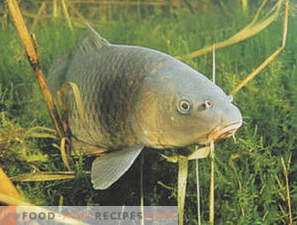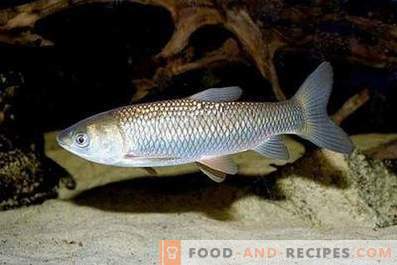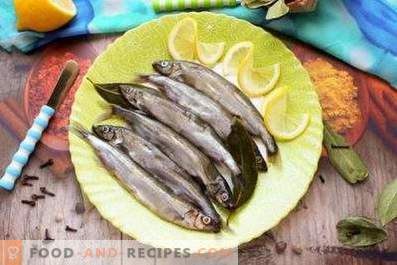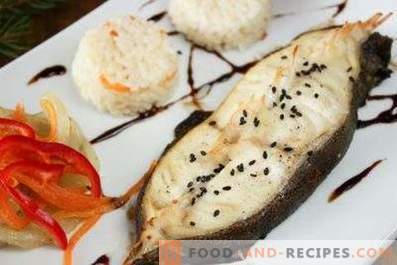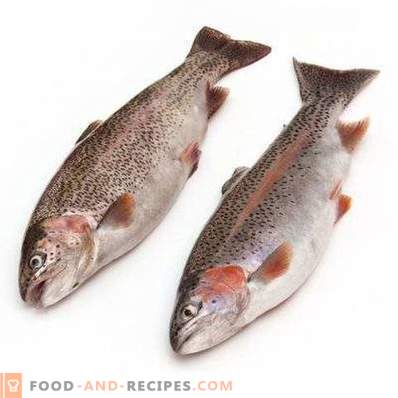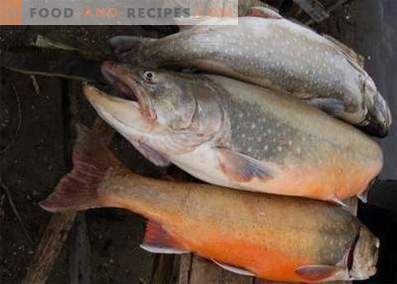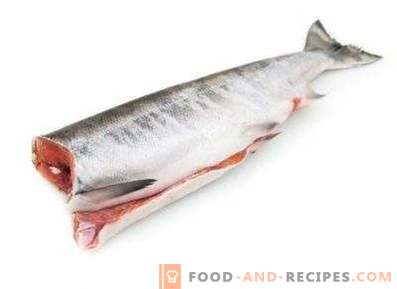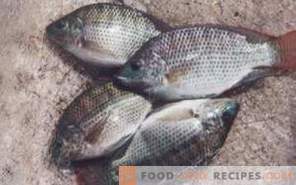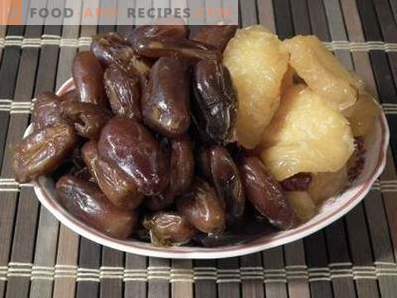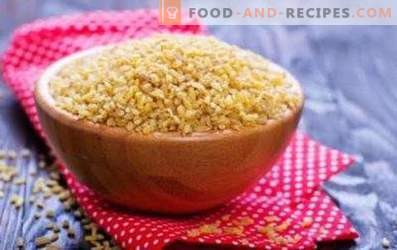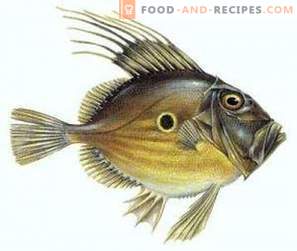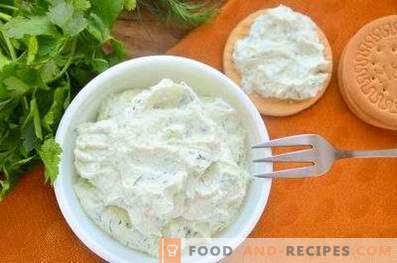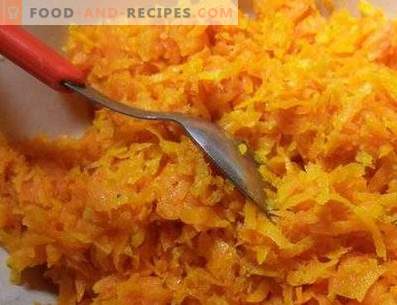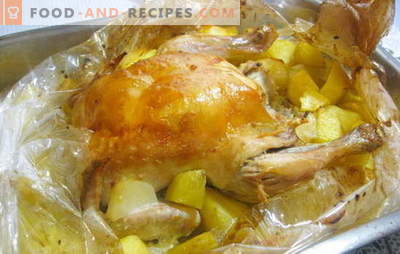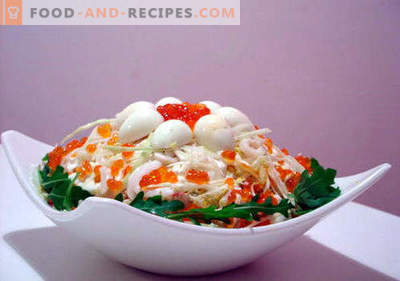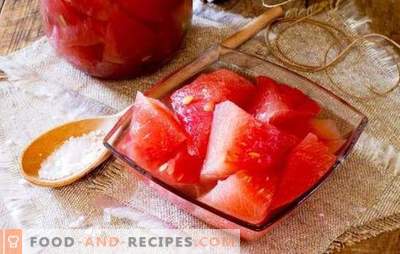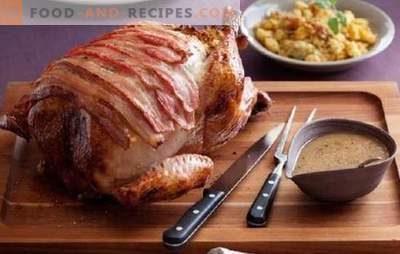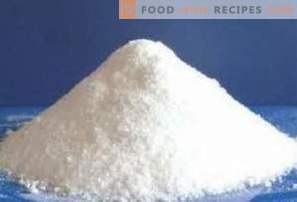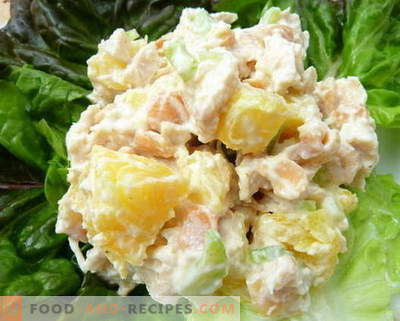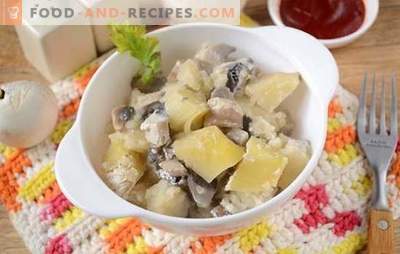
Crucians are ray-finned fish belonging to the carp family. Representatives of this genus, including 5 species, live in freshwater bodies of water in Europe and Northern Asia. In addition, they are found in rivers, lakes and ponds in the United States and Canada.
Crucian carp is a commercial fish and a widespread object of pond fish culture. Gentle meat of representatives of this kind is appreciated in cooking for a pleasant, slightly sweetish taste. It is eaten roasted, dried, boiled, stewed, dried, smoked, marinated and baked. In addition, carp cooked meatballs, soup and fillings for baking.
Appearance
All varieties of carp are similar in appearance. Representatives of this taxonomic group have a high oblate lateral body of yellowish-bronze or silver color, covered with large scales. The head of the fish is small, the mouth is terminal, the jaw teeth are absent. Small black eyes are surrounded by golden irises.
The long dorsal fin of a crucian is slightly rounded at the top. Its first beam is a hard serrated spike. The tail of the fish is large, weakly muscular. In the lower part of the body there are 2 pectoral, 2 pelvic and 1 anal fins. They all have a dark brown or gray color.
The size of the crucian depends on the habitat. In small, poor in feed, natural water bodies, the body length of this fish in the 2nd year of life does not exceed 6–7 cm, and its mass is 10–15 g. and weighing up to 4 kg.
Nutritional Value
100 g of carp fillet contains:
- 17, 683 g of proteins;
- 1, 799 g of fat;
- 78, 856 g of water;
- 1,577 g of ash;
- 0, 334 g of saturated fatty acids.
Cholesterol concentration in fish meat - 50, 014 mg per 100 g
Vitamins in fish
100 g of carp contains the following vitamins:
- retinol equivalent (A) - 19,681 μg;
- thiamine (B1) - 0.057 mg;
- Riboflavin (B2) - 0, 168 mg;
- ascorbic acid (C) - 0, 999 mg;
- tocopherol equivalent (E) - 0, 378 mg.
Along with this, nicotinic acid is a part of fish. The concentration of this compound is 5, 383 mg per 100 g of meat.
Useful items
Macronutrients in 100 g of crucian:
- potassium - 281, 014 mg;
- calcium - 69, 017 mg;
- magnesium - 26, 001 mg;
- sodium - 49, 874 mg;
- sulfur - 176, 322 mg;
- phosphorus - 219, 442 mg;
- chlorine - 166, 701 mg.
Trace elements in 100 g of fish:
- iron - 0, 719 mg;
- nickel - 6, 009 mkg;
- molybdenum - 3, 907 μg;
- fluorine - 428, 616 mkg;
- chrome - 54, 728 mkg.
Energy Value
100 g of raw carp fillet contains 86, 624 kcal. In the same portion of fried fish - 167, 832 kcal, boiled - 86, 723 kcal, marinated - 135, 167 kcal, dried - 124, 336 kcal, dried - 140, 106 kcal, stewed - 88, 414 kcal, smoked - 99 , 103 kcal, baked - 89, 303 kcal. The calorie content of 100 g of crucian cutlets is 112, 006 kcal, 100 ml of fish soup 38, 479 kcal.
Useful properties of fish
- Crucian is a rich source of easily digestible protein. Nutritionists recommend that those professionally involved in sports, recovering from injuries, prolonged illnesses and physical exertion, include at least 2 times a week meals prepared on the basis of it.
- Broths cooked from crucian carp contain a whole complex of extractive nitrogenous substances that stimulate the production of digestive juices, improve appetite, and activate intestinal motility.
- Calcium, fluorine and phosphorus present in the composition of the product strengthen the bone tissue, preventing the development of dental diseases and diseases of the musculoskeletal system.
- Nutrients that enter the body when eating dishes from crucian, stimulate brain activity, improve the ability to memorize information, increase concentration.
- Substances contained in the meat of a crucian carp have a positive effect on the functioning of the thyroid gland, are involved in the production of thyroid hormones, and hinder the development of metabolic failures.
- Nutritionists recommend that people suffering from diabetes include meals from this fish in their diet at least 4 times a week. It is proved that the beneficial substances present in its composition, can reduce the concentration of glucose in the blood and increase the susceptibility of body tissues to insulin.
- The crucian meat is a source of vitamin A. Because of this, it helps to increase visual acuity (including twilight), to prevent the development of disturbances in the work of the visual apparatus at elevated loads (for example, during prolonged reading or working at a computer).
- Dishes from this fish help to strengthen the immune forces and increase the body's resistance to infectious and catarrhal diseases.
- The carp fillet is rich in antioxidants. Regular consumption of it helps to protect cells from the negative effects of free radicals, reduce the likelihood of the formation of cancerous tumors, slow down the processes causing wear and aging of body tissues.
- Crucians contain a whole complex of compounds that strengthen the myocardium, increase the strength and elasticity of the vascular walls, normalize blood formation processes, and improve the nutrition of the brain with oxygen. Due to this, people who include the meat of these fish in the diet at least 2 times a week, have the opportunity to significantly reduce the risk of developing heart disease.
- Carp meat is rich in compounds that positively affect the functioning of the nervous system, preventing the occurrence of somnological disorders.
- Dishes that include this product improve the condition of the skin, support its elasticity and firmness, promote healing of cuts, burns and other injuries.
- The crucian meat improves the condition of hair and nails, accelerates their growth, reduces their fragility. Regular inclusion in the diet of this product helps reduce the risk of partial and complete alopecia.
Contraindications and harm of crucian
- Consumption of crucian dishes can cause allergic reactions. Therefore, people suffering from individual intolerance to fish and seafood should be completely excluded from their diet.
- Fried crucian carp is a high-calorie product. Its abuse can lead to the development of obesity.
- It is prohibited to eat carp caught in water polluted with organic fertilizers, pesticides, heavy metal salts or radionuclides.
- It is proved that the meat of this fish contains phenylalanine. For this reason, it should not be used by people suffering from phenylketonuria.
- A crucian carp is contraindicated in people who have previously been diagnosed with gout.
